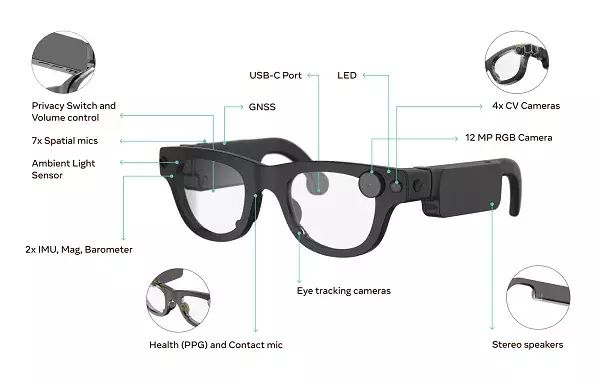Meta’s unveiling of its second-generation “Aria” AR glasses marks a pivotal moment in the evolution of augmented reality technology. With the ambitions to launch this innovative device into the consumer market by 2027, Meta is redefining our interaction with the digital landscape. While many tech companies dabble in AR development as a mere adjunct to their core products, Meta appears determined to genuinely transform how we perceive and connect with the world around us. The fruits of their labor promise advancements that could redefine daily interactions, making the prospect of immersive digital experiences not only conceivable but also functional and fashionable.
This commitment is evident in the design philosophy of Aria Gen 2. The device is engineered to be lightweight, weighing between 74 to 76 grams depending on the size. This focus on comfort is particularly pertinent in a market where user adoption is heavily influenced by the physical experience of wearable tech. With eight size variants to cater to diverse head shapes and facial structures, Meta is effectively acknowledging and addressing the human factors often overlooked in tech development.
Functional Design Meets Fashion
The introduction of folding arms—a seemingly simple feature—stands as a testament to Meta’s meticulous attention to user convenience. These arms not only enhance portability but also reflect a broader trend toward integrating practicality into stylish designs. The ultimate goal is to ensure that users feel compelled to incorporate these glasses into their daily attire rather than relegating them to the realm of gadgetry. This robust approach could foster a new wave of wearable tech acceptance, positioning AR glasses as a modern accessory akin to smartphones or sunglasses.
Moreover, Meta’s insistence on improving user engagement through enhanced camera sensors capable of adaptable performance in various lighting contexts is notable. By expanding the field of view beyond what its predecessor offered, the company is paving the way for more immersive experiences. This is particularly crucial in practical applications where situational awareness is necessary, enhancing both the AR experience and ensuring user safety in dynamic environments.
Breaking Down the Tech: Tracking and Audio Innovations
Embedded within the nose pad is a contact microphone aiming to revolutionize audio capture in loud settings, a feature that could prove invaluable in crowded public spaces or bustling work environments. In addition, the integration of eye and hand tracking elevates user interaction, offering a sensory depth that blurs the line between the digital and the physical realms. As Meta refines these technical aspects, they are not just improving a product; they are reshaping the very nature of how users relate to their surroundings.
However, one must ponder the social implications of such drastic technological shifts. As users begin to utilize AR glasses that allow virtual engagements with the environment, the potential for isolation in digital realms becomes evident. There is an undeniable learning curve associated with this experience: our society must adapt to a new kind of interaction, one that entails conversing not only with people but also with visual data layered over the physical world. While the technology promises exciting opportunities for efficiency and connectivity, there lies an equally significant challenge in social acceptance.
The Future of Interaction: A Double-Edged Sword
Meta CEO Mark Zuckerberg has dubbed these AR glasses the “holy grail” of interactive technology—an ambitious claim that exemplifies his vision of a future wherein smartphones fade into obscurity. Imagine a world where waving your hands to manipulate digital information is as commonplace as sending a text message today. This may sound like science fiction, yet the fast-paced evolution of technology suggests that such realities often arrive quicker than anticipated.
Nevertheless, this future raises crucial questions: Will society embrace this shift, or will it resist such overt digital interactivity? The concept of users interacting with unseen systems raises concerns about privacy and social norms. As we look toward Meta’s upcoming collaborations with external developers, it remains to be seen how these partnerships will influence the applications developed and, consequently, how they will reshape our understanding of personal and communal experiences in this augmented reality.
In an age where digital and physical realms are becoming increasingly intertwined, what’s clear is that Meta’s Aria Gen 2 is not just a gadget; it’s a revolutionary step toward an immersive future that challenges our current lifestyle paradigms. The journey is only beginning, and how we navigate this uncharted territory will shape our collective reality.

